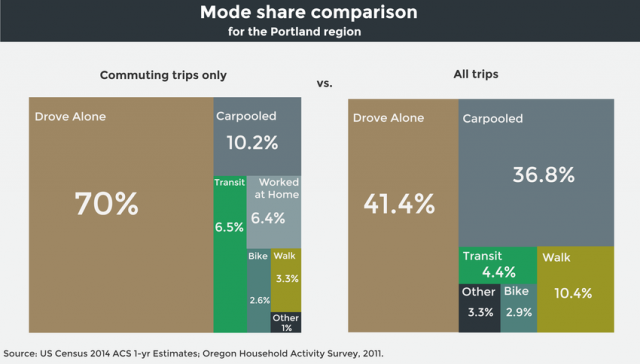
(All charts via Metro)
Metro is the only elected regional government in the United States. It’s also got one of the most interesting government communications teams in the country. Like MLB.com, Metro hires people to write journalism-style coverage of itself.
For its latest project, a four-part “regional snapshot” about transportation, the agency pulled out all the stops: original tilt-shift photography, narrative video, text drawn from at least a dozen interviews and a whole quiver of custom-made infographics. If you want a single overview on the basics of the region’s transportation situation, I’ve never seen a better one.
Here on BikePortland, we’re going to take advantage of this government-generated content and share a few of the many eye-opening charts Metro shared in the post. Here’s one about home and job locations that shows how interconnected, and yet different, the metro area’s four counties are:
Advertisement
Here’s a look at the Portland area’s unusual success in reducing auto usage … but note that the vertical axis doesn’t start at zero. The region isn’t so much of an outlier that we look impressive unless you zoom in.
Here’s one that busts the persistent myth that people of color “don’t bike” and putting other modes in context:
This chart shows how the Portland area is beating many peers on the metrics that matter most during rush hour: how much time and mileage it takes to get to work. (Sadly, the federal government that funds Metro’s transportation work continues to act as if the thing that matters is the velocity at which cars are moving — that’s not the same thing at all.)
And here’s a look at one of the big forces behind the idea that “more highways = more jobs”: truck freight. Freight has long been a significant part of Portland’s economy, and it still is — because even though the number of actual trucks is falling, the value of the stuff they’re carrying is going up.
Those are just a few of the insights to be found in Metro’s big, beautiful report. Check it out — you did pay for it, after all.
— Michael Andersen, (503) 333-7824 – michael@bikeportland.org
Our work is supported by subscribers. Please become one today.


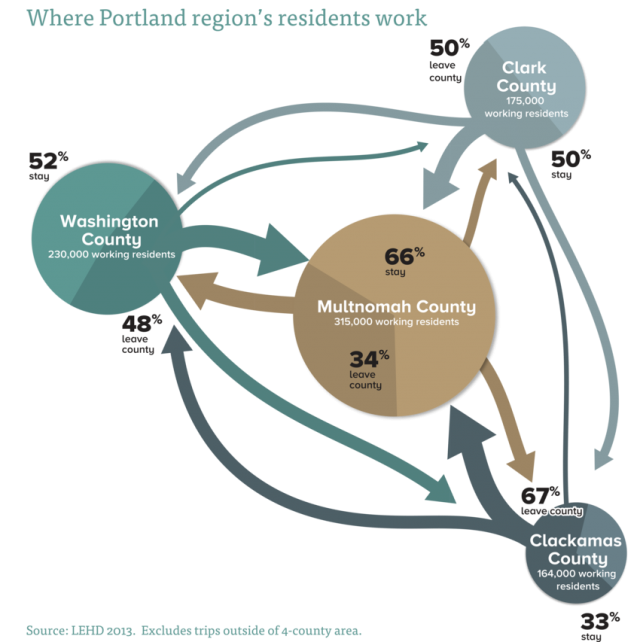
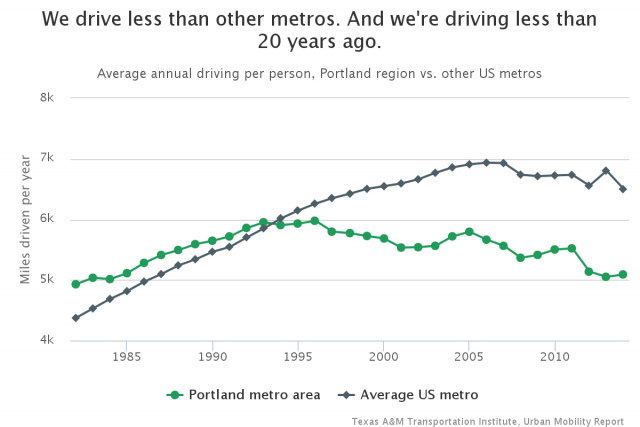
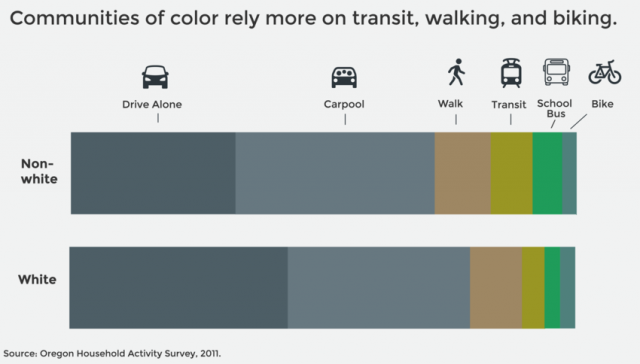
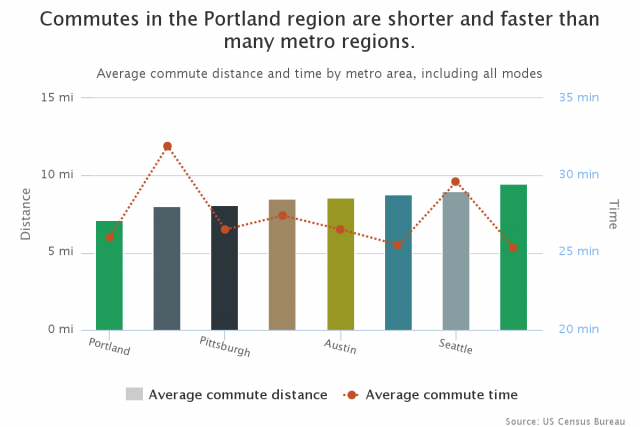
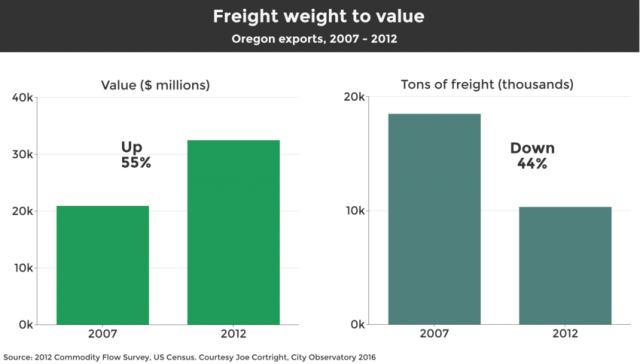


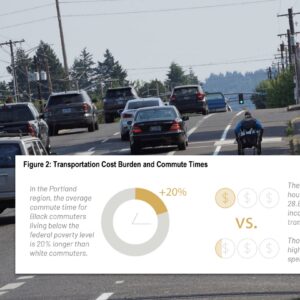
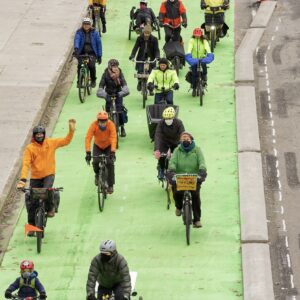
Thanks for reading.
BikePortland has served this community with independent community journalism since 2005. We rely on subscriptions from readers like you to survive. Your financial support is vital in keeping this valuable resource alive and well.
Please subscribe today to strengthen and expand our work.
I would guess the shift from trips alone for commutes to carpooled on all trips is due to families being together on the weekends.
The last chart is interesting. Portland is hugely leveraged in semiconductors — this means the stuff we’re moving on our transportation system is very, very high value-to-weight. It’s a great regional advantage.
http://www.brookings.edu/research/interactives/2015/export-monitor#38900
Software is even better in that regard. Most configurations of bits are both lightweight and compact, and you’d be surprised how much properly compressed software you can fit in a semi. Netflix is a real leader in this area, and is now able to ship about 100 streamed movies in a single box no larger than a small refrigerator.
I read a paper from Intel showing that as we progress on our people miniaturization tech, software and data in
general should become even more space efficient.
That stands to reason — less massive people should require less massive software.
It’s interesting how walking registers higher on both charts for “commutes” and “all trips” than bicycling. Bicycling barely beats out other, which I suppose are trips conducted on unicycles or jetpacks… Graphics suggest we’re still heavily reliant on automobiles for most trips, even when on average, we have the shortest commutes than the other metro areas. I suppose we can pat ourselves on the back for only drive 80% of the time for trips less than ten miles…
I think the biggest factor in “other” is motorcycles. Skateboards too.
Interesting diagramme.
So if the commute mode measures a ‘trip-avoided’ such as work from home…should the non commute diagram also include a ‘trip-avoided’ such as ‘on-line shopping’? Just think’n.
Thanks for including the county level data on commute trip exporting…if Clackamas exports 67% of its workers then why is it that Clark County is always the poster child for this phenomenon when its has a much lower rate and almost the same as Washington County.
Huh? Sounds like a lot of mis-reporting out there…
I think it’s mostly that Clark County claims to not be a suburb; Ft. Vancouver was founded before Portland and all that.
It’s more the concentrated impact on the system that results from Clark County commuters that makes them the “poster children”, if you will. Yes, more Clack and Wash Co residents in sheer numbers and percentages leave their county for work. But they have many routes to use, compared to Clark Co residents. They don’t all funnel onto just two bridges across a major navigable waterway, creating significant congestion problems on the Interstate system.
Looking closer at the Communities of Colour chart…perhaps it would be more correct to says that communities of colour rely more on carpooling, transit, and school buses at a significant level. Waking and biking seem pretty similar just visually looking at the chart.
Good point.
I would drive less if I could afford to live in Hilsboro were my job is. I live in Portland. I would take the train if it was faster than driving
78% car in one, 80% car in the other. Most people still driving everywhere. How can we get people to drive less?
We can get people to drive less without even changing the percentages.
I think the key is very simple — make driving more expensive. There are a lot of externalities in driving, and rolling some of those into the cost of driving would be a good start.
Sure, but this isn’t a very equitable statement given the current structure of our transportation grid. It’s cheap to drive, somewhat cheap to take public transportation, and bicycling is completely free unless you have to acquire the equipment before hand.
Most poor people don’t have the buffer to have a dramatic increase in driving over a short period of time.
And the public transportation system isn’t the most convenient when you have a family and need to bounce around the city. Remember, convenience doesn’t always mean arriving to your destination any faster than an alternative mode a transport.
Michael, only have of the city names are visible on the second-to-last chart. Can this be fixed?
Hi Joseph,
It’s a problem with how long the city names are; depending on the width of one’s browser some can get squeezed out. You can see the original chart here: https://cloud.highcharts.com/show/ozihaq
Half, I mean
these numbers are sobering. They emphasize that Portland is first and foremost a car-city, despite how people like to talk about it.
One thought: we often focus on bike infrastructure and it is an important part of increasing bike ridership. But we neglect the culture that exists around using cars. Using the car is the norm; using other modes of transportation is then often not even considered. How can we change this culture?
Portland, and the surrounding region, is much less car-centric than other US metro areas. Particularly so in the areas where there is good transit, walking and bike infrastructure. But there are still too many places where people don’t have options. We need to renew our commitment to building good choices into our transportation system, and work on getting the pricing correct (both for driving and parking). That will take a long time.
I look forward to a breakthrough in battery technology, really allowing for ebikes to take off—both aesthetically and economically. Make biking extremely easy, fun, and convenient!
Yes, Portland is less car-centric than other areas and investing in infrastructure and new technology will increase bike ridership.
But let me push back a little bit regarding the cultural aspect: leading European cities have a bike ridership that is a level higher than the one here. I see these places as examples of the kind of bike ridership that could exist here as well — perhaps not as high as 35% or 40% but 20, 25%.
Part of that is infrastructure. But being European, I wondering whether part of this is also culture. Here in the U.S. people emphasize choices and no one wants to be worse off. So people say you could ride your bike but it is your choice whether or not you’ll do it. I think one reason why some of the cities in Europe have taken off is because the citizens changes the conversation around taking your car versus other modes of transportation. I think that is an important but often overlooked aspect when trying to increase bike ridership.
I live in central NE. I figure that about half of the people on my block could commute to work on bikes, without e-assist. I am the only one doing it. The bike infrastructure from my place to downtown is excellent. So there is a lot of potential here that seems to have little to do with infrastructure or technology.
Where do we want to go as a city and as citizens who use bikes? Are we content with a decent bike infrastructure and giving people options? Or do we want to have a higher non-car modal share?
It’s convenience.
When I moved to Portland in 2008, I didn’t have a car. I put in—somewhere in the ball park of 18,000 bike commute miles over a six year period.
I rode everyday to work, regardless, all over the city. I rode long distance on the weekends. Cycling was my life. All I did was work in the cycling industry and ride my bike. It was challenging getting groceries or going on a date and not being soaked either before or after. Spontaneously meeting up with friends was more difficult and I was less likely to ride across town to do it. I really never could leave town unless it was on my bike are carpooling. Confined to the city limits.
2014. I went back to school. I got a job in Vancouver. I tried life without a car. EXTREMELY DIFFICULT. So, I purchased a vehicle. And I have to say, my life has been so much easier. I can work, attend class, zip around the city, meet up with friends, get groceries, and exercise, all in one day, one evening in fact. Leaving town whenever I want is the best part.
Back in 2008, I thought it was a sin to drive. Currently, I feel pretty bad about my car addiction, but it sure makes a busy life a lot more convenient. Cars are time machines.
I’m extremely sympathetic to the bike cause. Someday I hope to return to being a full bike commuter, but now is not an option.
Now, try convincing someone that has always known the convenience of the car to get out and ride their bike.
It’s a giant hurdle to overcome…
And that’s why I think the market for ebikes hasn’t even come close to being tapped. Minimal effort to cover 20 miles in a single day. Lots of storage and carrying capacity for you bike. Shoot, get on a recumbent with a wind faring and you’ll barely get wet!
I’d be really interested to see the racial breakdown of various transportation choices broken down a little more than just “white” and “non-white”. I suspect there are huge variations between the various “not white” communities. Even more interesting would be a non-racial breakdown of various communities, that, for example, acknowledged the large Russian immigrant population, or the difference between the Ethiopian immigrant population and other people of African descent. As it stands “white” and “not white” are basically meaningless categories.